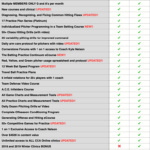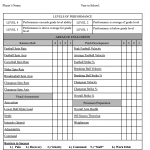My Goal Setting Process for 2015
It’s that time of year again. We all set new years resolutions that we have every intention of following. Losing 20 pounds, flossing every day, being a better husband/dad, getting a raise, growing your business… these are all very admirable and positive resolutions that would make a positive impact in most of our lives.
But these “resolutions” are missing something very important… the how.
How are you going to lose 20 pounds? How will you floss every day when you haven’t your entire life? How will you grow your business?
The problem with many resolutions, and goals for that matter, is that there is no path to achieving them. There is a light at the end of the tunnel, but we have no idea where the tunnel is, or if we can get there.
The purpose of this blog post is to help baseball coaches with the goal setting process for themselves and their teams in 2015 as well as to publicly declare my goals for the 2015 season as well as the process I will go through to reach them.
How to set goals
1.) Set up your goal setting session
That’s right, you have to plan for your goal setting session. I’ve made the mistake of just walking into the room with note cards and just saying “everyone write down three goals.” You and your team get absolutely nothing out of it.
Before you walk into that room, you must be prepared to give your athletes an explanation of what makes a good goal and what makes a bad goal (that will be covered in the rest of the blog), and how to set a process or road map to meet those goals.
This year, I plan on spending at least an hour planning my goal setting meeting with my players to ensure that they understand what makes a good goal, and how to see that we follow through on them.
It may seem somewhat silly to go through a lengthy goal setting process with younger players, or even high school players, but goal setting is a process, and the more times they go through the process they will get better at it. Learning this process will benefit them later in life.
2.) Specific goals
If you give your players a note card and tell them to write down their goals, you will get things like “Get better,” and “Try my hardest.” These goals are unspecific, too general, and there is no way to measure them.
The goal should specifically state what they want to get better at. Part of this process is the player being able to know what they aren’t very good at, and where their game needs improvement.
Because many players don’t naturally have this introspection, it might be helpful beneficial to give them our strengths and weaknesses rating system prior to their goal setting session to help them focus what they need to work on.
Make sure they understand that it is OK to work on your strengths as well as your weaknesses when they are setting their goals.
[wp_ad_camp_3]
3.) Pushes you, but not impossible
I saw a great quote the other day that applies to goal setting, “the only way to find your limits is to push them.” This is exactly what goals should do, push our limits.
If your long term goal is to hit bench press 300 pounds (not recommended for baseball players, just an example) and you currently bench press 150 pounds, it wouldn’t make any sense to try to bench 300 pounds until you get it. You would incrementally work your way up from 150. Goal setting or a season should work the same way.
We’ve all seen this kid, “I want to hit .600 and hit 15 home runs, and go 10-0 on the mound with 12 strikeouts per 7 innings.” He is either being unrealistic, or is about to be selected in the first round of the June MLB draft.
Believe it or not, I’m not the only person writing a “resolutions” type blog post around this time of year. I’ve read several, and heard several on the podcasts that talk about “dreaming big” in 2015.
Hitting .600 with 15 bombs is probably really a “dream” for many players (not to mention it fails many of the other qualifications of a quality goal) and it is not an achievable goal.
Goals should be difficult to achieve and should push an athlete or coach to achieve highly, but should not be unrealistic or impossible to reach. If a goal is too easy to achieve, it won’t motivate them to achieve. If a goal its too difficult, it will be discouraging and it unlikely to be monitored.
4.) Goals should be measurable
We need to have some way of knowing if we reached our goals or not. If players simply say “I want to work harder.” There is no way to monitor that goal, and there is no way to determine if the goal was met or not.
Part of the goal setting process will be to determine how they will measure their goals.
5.) Performance goals, not outcome goals
Another problem with goals like “I want to hit .600 with 15 home runs” is that much of that is out of the player’s control. A player can have a day where they hit the ball right on the screws four times and goes 0-4. They can hit 10 home runs in the first half of the season, then the word gets out and nobody pitches to them the second half of the season.
While traditional stats like ERA, batting average, RBI, wins, and home runs are measurable, they are outcome oriented statistics and are often out of the players control. Instead, have them determine (or give them the criteria) for what a quality at bat is and measure that.
[wp_ad_camp_1] [wp_ad_camp_1]
Have them determine what a quality inning or quality outing is (ex. 5 innings or more, 3 runs or less, 2 walks or less) and have them measure those to determine their success.
While not ALL goals will be performance oriented, having more of them than outcome oriented goals will give players and coaches a more realistic view of their actual performance.
5.) Not absolute
Goals that have no wiggle room are often unattainable, and get “broken” early in a season. For example, if a team’s goal is to go undefeated and they lose their second game, that goal is no long attainable. If your goal is to not strike out all season and you strike out your first at bat, that goal is out the window.
Goals should have some wiggle room for error because not everything will go perfectly as planned. Losing a single game, walking a single hitter, or striking out one time should not end a goal.
6.) Flexible
Even though we don’t want our goals to be absolute, we do need to have the ability to adjust our goals if they become too easy or too difficult as the season progresses.
If a player’s goal is to have 60% quality at bats, and they are at 35% half way through the season, it is unlikely they will be able to reach 60% for the season. That goal may need to be adjusted to 50% for the entire season to make it achievable, but challenging.
7.) Follow up
If you just set the goals, then never revisit them, there is no way to hold yourself or your team accountable. To ensure this happens, I will be setting a reminder in my phone two times during the season to have a “goal revision meeting” where we will meet as a team and discuss the progress we have made on our goals, and to redo our goals if necessary.
My goals for 2015
1.) Reach more players on my team every day.
How I will achieve this goal: Utilize warm-up time, and individual defense time to reach players. I will give my assistant coaches the tools they need to work with my specialty groups (pitchers, infielders, hitters) so I can work with other specialty groups and work with more players each week.
How I will measure this goal: End of season exit interviews (see form below)
2.) Improve velocity in our pitchers without losing pitch-ability
How I will achieve this goal: I reworked our “Daily Dozen” pitching drills this year so that pitchers can work on explosiveness and athleticism with the goal being learning how to explosively repeat their delivery.
Cornerstone’s “Top 10 Things Pitchers Must Do” document will help guide our pitchers so they understand to be more athletic, and less “mechanical.”
How I will measure this goal: We will pre-test and post-test velocity in tryouts and throughout the season. But remember, this goal isn’t just about throwing harder, it’s about throwing harder with command.
To measure command, I’ll utilize our quality strike chart for bullpens and our pitcher attacking chart for games. Our historical averages in bullpens are 35% Quality Strikes and 63% Strikes. I should see velocity numbers jump, and QS and strike numbers remain the same or increase.
3.) Cut down our team’s strike outs without decreasing productivity and power numbers.
In 2013, we hit a whopping 3 home runs and 37 extra base hits as a team which led to our goal of increasing our power numbers in 2014. By implementing a power oriented offseason conditioning program, and changing the intent of our batting practice and our approach with less than two strikes, we were able to increase our power numbers to 17 home runs and 85 extra base hits (the home run total led our entire area).
The best part about that change for me was that our strike out rate was exactly the same in 2014 as it was in 2013, 19%. But as I looked back at our numbers from previous season, I noticed that we have had strike out rates as low as 12%. I’d like to keep the power number we have (.445 team slugging% or higher), but decrease our strike out rate to under 15%.
How I will achieve this goal: There’s a very fine line between practicing a two strike swing too much and not practicing it enough. If we practice it too much it leads to a very passive swing even with less than two strikes, which will decrease our power number.
To achieve our goal of cutting down our strike out rate, we need to give kids a more realistic look during batting practice to help them with pitch recognition. Our random count game combined with mixing up pitches more in batting practice (if my arm holds up!) should help with pitch recognition.
We will also touch on two strike approach on a more regular basis (see #4 for how this will happen).
How I will measure this goal: I know that each team varies in talent, but I feel that this year's team should be of equal or better on offense than last year's team. Because of that, we should have a similar slugging percentage (within .015 of .445) and decrease our strike out percentage to 15% or under.
4.) Cover EVERY topic we feel is important every 10 practice
This is a huge goal for me. I am absolutely sick of getting to the point in the season where we are playing more games than we have practices and having a situation creep up that we haven’t practiced since the beginning of the season. That’s on me as a coach, and it needs to not happen this year.
How I will achieve this goal: I’m creating a series of 10 incredibly detailed practice plans that have variety of activities, tactical games, and cover every single topic we feel is important at least once in the series of plans.
Assuming we have 2-3 practices per week , we should get to skill and tactic at least once in a 2-3 week period. No more excuses of “we haven’t practiced that since the beginning of the season.” Nothing will be left out.
There are two additional benefits to this system. One is that I can just hand this series of 10 plans to my lower level coaches and they can implement the exact same practices as the varsity. The second is a personal one, but I spend about an hour to two hours planning my practices every day. This planning time is now gone. I just pull the next plan in the series, tweak it a bit if needed and I’m done!
That's an extra hour or two I'll be able to spend with my family every night!
I’ll make these available to you when I’m finished with them, but with the amount of detail I’m putting into them (explanation of every single drill, skill and tactical explanation, video of several of the drills) it is taking about 6 hours to write each one. It’s a huge investment up front, but I know it will pay off in saved planning time for years to come.
If you’d like me to let you know when the series is finished, sign up here.
There is a HUGE number of resources mentioned in this blog post. You can find links to them below. Some of the links will take you to the resource, but some of what I mentioned above are only available to Cornerstone Elite Members.
Resources:
Quality Strikes/In game pitching chart
Offseason conditioning program
Top 10 Things Pitchers Must Do To Maximize Their Ability
More from my site
 CCA Podcast 256 – Developing barrel accuracy with your hitters
CCA Podcast 256 – Developing barrel accuracy with your hitters What Makes a Good Hitting Drill?
What Makes a Good Hitting Drill? Effective Planning of Indoor Baseball Practice
Effective Planning of Indoor Baseball Practice  Great Article on the Case for Certification in Youth Sports
Great Article on the Case for Certification in Youth Sports CCA Podcast 212 – Running a Pitching Assessment With Your Team – Part 2
CCA Podcast 212 – Running a Pitching Assessment With Your Team – Part 2 CCA Podcast 042: In season hitting training
CCA Podcast 042: In season hitting training
 Posted by Kyle Nelson
Posted by Kyle Nelson- Posted in Coaching Philosophy
 Jan, 01, 2015
Jan, 01, 2015 1 Comment.
1 Comment.
Elite members login here
Check out what’s New/Hot!
Recognizing, Diagnosing, and Fixing Common Hitting Flaws eCourse The 3 metrics we tested on Blast motion sensors this year Sneak Peek Inside an Elite Q and A The batting practice continuum Elite Member’s area table of contents 50+ “Chaos” hitting drills
5 sample Chaos hitting drills FREE
Mental Skills and Culture Building The hitting pyramid Welcome Elite Member, Trey! Ideas for a pitcher first practice 12 week bat speed improvement plan Make plans this offseason to have your team playing their best baseball at the end of the year” Top 5 hitting drills to translate practice skill to game performanceHow we used Blast Motion sensors with a team in 2019
What to do if your hitters are overmatched Welcome Elite Member, Tommy! Setting your baserunners up for success Welcome Elite Member, Mike! A consulting call with Elite Member Matt FREE Web Clinic: Developing Athletic, Consistent, Extraordinary Infielders
 Coach Kyle Nelson
Coach Kyle Nelson
[…] Source: https://www.cornerstonecoachingacademy.com/goals-not-resolutions-baseball-coaches-2015/ […]